2005SOGC+原发性痛经诊疗共识指南
基于文献研究与专家共识法的原发性痛经中医证候研究

基于文献研究与专家共识法的原发性痛经中医证候研究原发性痛经是指在排除妇科疾病的情况下,经前或经期出现的疼痛症状,常伴有生活质量下降、工作和学习效率下降等问题,给女性朋友们的身心健康带来了很大的困扰。
中医作为我国传统医学的重要组成部分,对于原发性痛经疾病的诊断与治疗有着丰富的临床经验和理论依据。
本文将通过文献研究与专家共识法,探讨原发性痛经中医证候的研究,为临床诊疗提供参考依据。
一、文献研究1.原发性痛经的中医病因病机关于原发性痛经的中医病因病机,早在古代医籍《内经》中就有详细的记载。
《素问·经脉别论》中指出:“帝曰:女之经藏何如?岐伯曰:有病之经曰经痛,经痛之始生于风寒湿热。
帝曰:经痛非其病乎?岐伯曰:此病之中本也。
”可见,中医认为原发性痛经与外感邪气、情志不畅、气血运行不畅等因素密切相关。
现代文献研究也证实,原发性痛经的发生与雌激素、前列腺素、儿茶酚胺等生理活性物质分泌失衡有关,而中医则认为这些生理活性物质的失衡是由于经络气血不畅所致。
2.原发性痛经的中医证候根据《中医临床诊断疾病标准》中对原发性痛经的分类,可将其分为肝郁型、气滞型、血瘀型、瘀热型、虚寒型等多种中医证候。
肝郁型主要表现为情志不畅、胸闷胁痛、月经不调等;气滞型主要表现为腹部胀痛、情绪不宁、舌质淡红等;血瘀型主要表现为月经色暗、不畅或伴有血块、腹部胀痛等;瘀热型主要表现为腹痛、月经不畅且颜色深红等;虚寒型主要表现为月经量少、颜色淡、腹痛缓解等。
这些中医证候分型为临床诊断及治疗提供了依据。
3.原发性痛经的中医治疗在中医治疗原发性痛经中,常用的治疗方法包括针灸、中药治疗和调理饮食。
针灸疗法主要是通过穴位刺激来疏通经络、调和气血,常用的穴位包括关元、足三里、太冲等;中药治疗常采用活血化瘀、温经散寒、调和气血的方法,如当归、川芎、姜黄等药物常用于治疗原发性痛经;调理饮食则是通过对月经周期进行合理调理,避免食用寒凉生冷之物。
这些治疗方法在临床中应用广泛,且具有一定的疗效。
原发性痛经的中医诊治
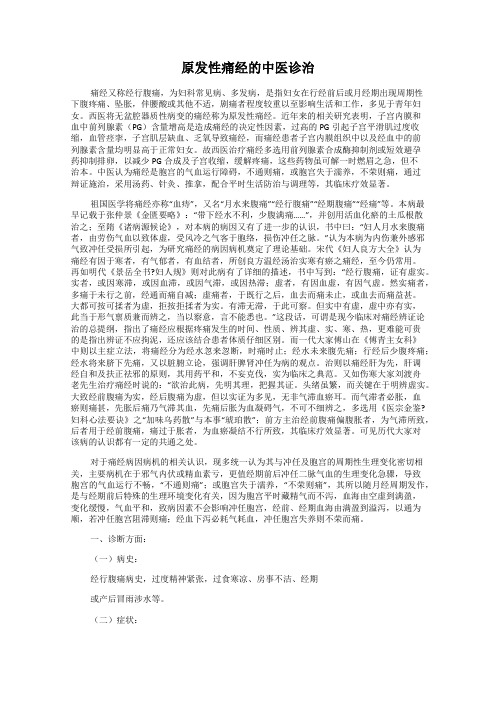
原发性痛经的中医诊治痛经又称经行腹痛,为妇科常见病、多发病,是指妇女在行经前后或月经期出现周期性下腹疼痛、坠胀,伴腰酸或其他不适,剧痛者程度较重以至影响生活和工作,多见于青年妇女。
西医将无盆腔器质性病变的痛经称为原发性痛经。
近年来的相关研究表明,子宫内膜和血中前列腺素(PG)含量增高是造成痛经的决定性因素,过高的PG引起子宫平滑肌过度收缩,血管痉挛,子宫肌层缺血、乏氧导致痛经,而痛经患者子宫内膜组织中以及经血中的前列腺素含量均明显高于正常妇女。
故西医治疗痛经多选用前列腺素合成酶抑制剂或短效避孕药抑制排卵,以减少PG合成及子宫收缩,缓解疼痛,这些药物虽可解一时燃眉之急,但不治本。
中医认为痛经是胞宫的气血运行障碍,不通则痛,或胞宫失于濡养,不荣则痛,通过辩证施治,采用汤药、针灸、推拿,配合平时生活防治与调理等,其临床疗效显著。
祖国医学将痛经亦称“血痔”,又名“月水来腹痛”“经行腹痛”“经期腹痛”“经痛”等。
本病最早记载于张仲景《金匮要略》:“带下经水不利,少腹满痛……”,并创用活血化瘀的土瓜根散治之;至隋《诸病源候论》,对本病的病因又有了进一步的认识,书中曰:“妇人月水来腹痛者,由劳伤气血以致体虚,受风冷之气客于胞络,损伤冲任之脉。
”认为本病为内伤兼外感邪气致冲任受损所引起,为研究痛经的病因病机奠定了理论基础。
宋代《妇人良方大全》认为痛经有因于寒者,有气郁者,有血结者,所创良方温经汤治实寒有瘀之痛经,至今仍常用。
再如明代《景岳全书?妇人规》则对此病有了详细的描述,书中写到:“经行腹痛,证有虚实。
实者,或因寒滞,或因血滞,或因气滞,或因热滞;虚者,有因血虚,有因气虚。
然实痛者,多痛于未行之前,经通而痛自减;虚痛者,于既行之后,血去而痛未止,或血去而痛益甚。
大都可按可揉者为虚,拒按拒揉者为实。
有滞无滞,于此可察。
但实中有虚,虚中亦有实,此当于形气禀质兼而辨之,当以察意,言不能悉也。
”这段话,可谓是现今临床对痛经辨证论治的总提纲,指出了痛经应根据疼痛发生的时间、性质、辨其虚、实、寒、热,更难能可贵的是指出辨证不应拘泥,还应该结合患者体质仔细区别。
原发性痛经的医治

原发性痛经的医治原发性痛经,想必是许多姑娘们都会遇到的麻烦,痛经一来,恐怕是吃不下睡不香。
一片布洛芬什么的这类止痛药下去又效果糟糕,忍不住想抓起药板子往垃圾桶里砸——为啥妇产科学的教科书,妇科医生,各大指南上明明都说了,非甾类止痛药的有效性相当不错,有效率可达80%,而且安全性也很好,应该是痛经治疗的第一选择,可是既然如此,为什么许多女生都觉得使用效果这么差?这就要从原发性痛经的原因说起了。
原发性痛经的原因,现在认为和月经期间子宫内膜的前列腺素(prostaglandin, PG)含量升高有关,前列腺素是个大家族,导致痛经的是其中的PGF2α,PGF2α是花生四烯酸脂肪酸的衍生物,在月经周期中,分泌期子宫内膜前列腺素浓度较高,月经期的时候由于子宫内膜脱落,子宫内膜细胞破裂,从而是其中的两种前列腺素被释放到血液中,而PGF2α会导致子宫平滑肌过度收缩,以及血管的痉挛,从而导致子宫缺血,缺氧,因此引起痛经,此外,过多的前列腺素进入血液循环,还会引起心血管和消化道等症状。
而各种医学书籍里推荐的非甾类止痛药,也就是我们经常说的布洛芬,酮洛芬,双氯芬酸,甲芬那酸,萘普生,以及阿司匹林,这类药物通过抑制花生四烯酸到前列腺素的这步反应,前面说了,会导致痛经的前列腺素PGF2α是花生四烯酸的衍生物,而花生四烯酸要转化为前列腺素,需要环氧化酶(Cyclooxygenase, COX)的参与,非甾类止痛药的功能就是抑制COX-2,从而使得前列腺素分泌量下降,因此避免痛经的出现。
而COX家族有三种同工酶,分别为COX-1,COX-2和COX-3,其中COX-3是COX-1的突变体,所以也被称为COX-1B,由于这几种酶的结构接近,因此传统的非甾类止痛药会把两种酶一起抑制了,于是没干什么坏事的COX-1就跟着一起躺枪了,COX-1并不是导致痛经的坏家伙,而是在许多哺乳动物细胞中广泛存在,起着参与细胞信号传导,维持组织稳态,以及保护消化道粘膜,减少胃酸分泌,降低胃蛋白酶含量等作用,这也是为什么许多传统的非甾类止痛药副作用包括消化道溃疡的原因(新型的非甾类止痛药,如美洛昔康,塞来昔布等,对COX-1的抑制作用远远弱于对COX-2的抑制作用,因此对肠胃的刺激性相对于老式的非甾类止痛药)。
经前针刺干预对原发性痛经的疗效观察
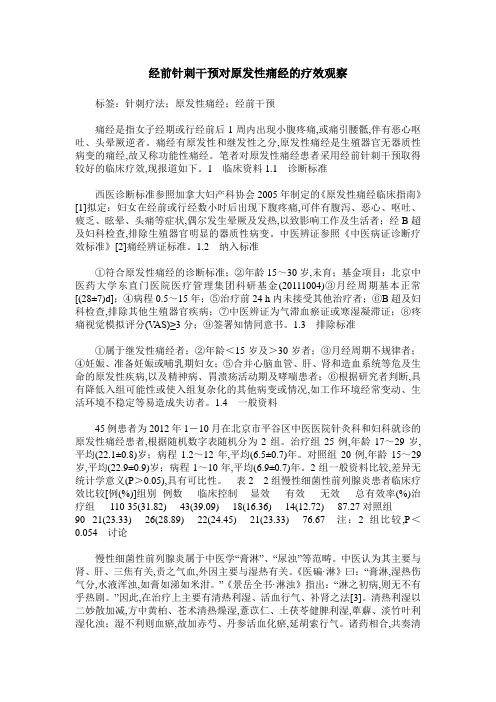
经前针刺干预对原发性痛经的疗效观察标签:针刺疗法;原发性痛经;经前干预痛经是指女子经期或行经前后1周内出现小腹疼痛,或痛引腰骶,伴有恶心呕吐、头晕厥逆者。
痛经有原发性和继发性之分,原发性痛经是生殖器官无器质性病变的痛经,故又称功能性痛经。
笔者对原发性痛经患者采用经前针刺干预取得较好的临床疗效,现报道如下。
1 临床资料1.1 诊断标准西医诊断标准参照加拿大妇产科协会2005年制定的《原发性痛经临床指南》[1]拟定:妇女在经前或行经数小时后出现下腹疼痛,可伴有腹泻、恶心、呕吐、疲乏、眩晕、头痛等症状,偶尔发生晕厥及发热,以致影响工作及生活者;经B超及妇科检查,排除生殖器官明显的器质性病变。
中医辨证参照《中医病证诊断疗效标准》[2]痛经辨证标准。
1.2 纳入标准①符合原发性痛经的诊断标准;②年龄15~30岁,未育;基金项目:北京中医药大学东直门医院医疗管理集团科研基金(20111004)③月经周期基本正常[(28±7)d];④病程0.5~15年;⑤治疗前24 h内未接受其他治疗者;⑥B超及妇科检查,排除其他生殖器官疾病;⑦中医辨证为气滞血瘀证或寒湿凝滞证;⑧疼痛视觉模拟评分(V AS)≥3分;⑨签署知情同意书。
1.3 排除标准①属于继发性痛经者;②年龄<15岁及>30岁者;③月经周期不规律者;④妊娠、准备妊娠或哺乳期妇女;⑤合并心脑血管、肝、肾和造血系统等危及生命的原发性疾病,以及精神病、胃溃疡活动期及哮喘患者;⑥根据研究者判断,具有降低入组可能性或使入组复杂化的其他病变或情况,如工作环境经常变动、生活环境不稳定等易造成失访者。
1.4 一般资料45例患者为2012年1-10月在北京市平谷区中医医院针灸科和妇科就诊的原发性痛经患者,根据随机数字表随机分为2组。
治疗组25例,年龄17~29岁,平均(22.1±0.8)岁;病程1.2~12年,平均(6.5±0.7)年。
对照组20例,年龄15~29岁,平均(22.9±0.9)岁;病程1~10年,平均(6.9±0.7)年。
原发性痛经临床辨治
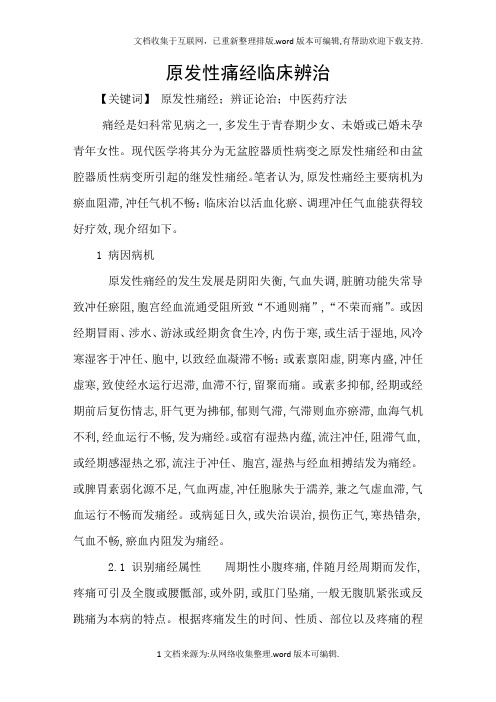
原发性痛经临床辨治【关键词】原发性痛经;辨证论治;中医药疗法痛经是妇科常见病之一,多发生于青春期少女、未婚或已婚未孕青年女性。
现代医学将其分为无盆腔器质性病变之原发性痛经和由盆腔器质性病变所引起的继发性痛经。
笔者认为,原发性痛经主要病机为瘀血阻滞,冲任气机不畅;临床治以活血化瘀、调理冲任气血能获得较好疗效,现介绍如下。
1 病因病机原发性痛经的发生发展是阴阳失衡,气血失调,脏腑功能失常导致冲任瘀阻,胞宫经血流通受阻所致“不通则痛”,“不荣而痛”。
或因经期冒雨、涉水、游泳或经期贪食生冷,内伤于寒,或生活于湿地,风冷寒湿客于冲任、胞中,以致经血凝滞不畅;或素禀阳虚,阴寒内盛,冲任虚寒,致使经水运行迟滞,血滞不行,留聚而痛。
或素多抑郁,经期或经期前后复伤情志,肝气更为拂郁,郁则气滞,气滞则血亦瘀滞,血海气机不利,经血运行不畅,发为痛经。
或宿有湿热内蕴,流注冲任,阻滞气血,或经期感湿热之邪,流注于冲任、胞宫,湿热与经血相搏结发为痛经。
或脾胃素弱化源不足,气血两虚,冲任胞脉失于濡养,兼之气虚血滞,气血运行不畅而发痛经。
或病延日久,或失治误治,损伤正气,寒热错杂,气血不畅,瘀血内阻发为痛经。
2.1 识别痛经属性周期性小腹疼痛,伴随月经周期而发作,疼痛可引及全腹或腰骶部,或外阴,或肛门坠痛,一般无腹肌紧张或反跳痛为本病的特点。
根据疼痛发生的时间、性质、部位以及疼痛的程度,结合月经的期、量、色、质及全身证候,辨明痛经的寒热虚实,结合兼症及素体情况、舌脉特点,可以辨其病在何脏何经,或气病血病。
一般痛在经前、经期多属实;痛在经后多属虚。
疼痛剧烈拒按多属实;隐隐作痛喜揉喜按多属虚。
得热痛减多为寒,得热痛剧多为热;绞痛、冷痛者属寒,灼痛者属热。
痛甚于胀,血块排出则疼痛减轻或刺痛者多为血瘀;胀甚于痛多为气滞。
痛在两侧少腹病多在肝,痛连腰际病多在肾。
2.2 辨治2.2.1 温经散寒,除湿化瘀本法适用于寒湿凝滞,经行不畅之证。
基于文献研究与专家共识法的原发性痛经中医证候研究

基于文献研究与专家共识法的原发性痛经中医证候研究原发性痛经是指在没有明显妇科疾病的情况下,经期出现严重腹痛、腰腹部不适及伴随其他症状,严重影响生活质量,这是女性生殖系统常见的临床症状。
虽然原发性痛经是一种良性疾病,但却给患者带来了不小的痛苦与困扰。
对于原发性痛经的管理,中医药已经积累了相当丰富的经验,其中的证候研究尤为重要。
一、文献研究1.1 原发性痛经的定义及病因原发性痛经是指在排除妇科疾病的情况下,由子宫内膜功能性异常引起的一种周期性腹痛。
其病因主要是子宫内膜的异常增生、分泌及脱落所造成的子宫内膜的异位、子宫肌壁的异常收缩等。
这些异常会导致子宫血管收缩、缺血、缺氧,产生疼痛。
1.2 中医药在原发性痛经中的治疗中医药在原发性痛经的治疗上以调整经血为重点,辅以疏肝理气、温经散寒等办法。
常用的中药有活血化瘀、调经止痛的丹、芪、苓、术茯中药方。
针灸、艾灸、拔罐等中医治疗手段也被广泛应用。
1.3 文献研究结果根据文献研究发现,中医药治疗原发性痛经效果确切,不仅可以缓解经痛,还能改善月经不调等症状。
而且,中医药治疗原发性痛经的作用机制也得到了广泛研究,主要表现为活血化瘀、调经止痛、调整内分泌和免疫系统等多方面。
1.4 目前存在的问题尽管中医药在治疗原发性痛经中取得了一定的成绩,但仍然存在一些问题。
中医药治疗原发性痛经的标准化程度不高,缺乏统一的诊疗意见和治疗方案。
在临床实践中,部分医生对中医药治疗原发性痛经的认识还停留在经验层面,对于证候辨识的严谨程度不够,从而影响了治疗效果。
二、专家共识2.1 中医专家意见在针对原发性痛经的中医药治疗中,专家们普遍认为首先要重视辨证施治。
需要根据患者的脉象、舌诊等症状进行综合分析,确立病位病性,然后再进行针对性的治疗。
还要结合患者的年龄、体质、生活习惯等个体差异,制定个性化的治疗方案。
西医专家认为,对于原发性痛经的治疗应以缓解疼痛为首要目标。
在此基础上,可以结合中医药治疗,以增强疗效。
原发性痛经的疗法

原发性痛经的疗法原发性痛经即功能性痛经,是指月经期疼痛,常呈痉挛性,集中在下腹部。
其他症状包括头痛乏力、头晕、恶心呕吐、腹泻、腰腿痛,是年轻女性十分常见的病症,原发性痛经不伴有明显的盆腔器质性疾病。
昨夜急诊值班被一名年轻女性惊醒,该患者为原发性痛经病人,夜间突发痛经难以忍受就诊,因为这一块接触较少,经妇科会诊并给以治疗,晨起后文献了原发性痛经有关文献,其中一篇《临床原发性痛经诊疗指南》比较实用,现结合自身临床经验,初步解读如下:一、约90%的痛经都是原发性痛经,它通常在月经前出现,可持续1-3天,伴有下腹部疼痛、疲乏、恶心等多种症状,严重时影响生活质量,但能通过多种方式进行有效的控制。
对于月经量大、体重指数小于18.5、月经不调、年龄小于30岁、初潮小于12岁等是该病的高风险人群。
针对痛经需要鉴别期临床特征,现总结如下:1.原发性痛经:月经前数小时开始,1-3天缓解,在初潮后2年内以及年龄小于30岁的女性人群中尤其多见,通常无潜在病症、妇科检查结果常常无异常。
通常可通过改善生活方式和镇痛缓解症状。
2.继发性痛经:月经前数小时开始,可贯穿经期,年龄大于30岁女性较为常见,多由病症引起,常见于子宫内膜异位症,盆腔检查等妇科检查多可发现病症,需要通过治疗病变来缓解症状。
二、针对该病的一般疗法可以分为:1.改善身心状态:充足的睡眠、戒烟、戒酒、适当增加运动量(至少每周3次,每次30分钟),文献中特别指出对患者详细讲解痛经的有关知识,帮助其不惧怕月经,对痛经治疗有一定的心理暗示作用。
2.经期适度运动:建议降低日常运动的强度、避免竞技类运动,同时需要指出的是运动过程中应该避免压迫腹腔,建议以中等强度运动为主。
3.日常适当使用补充剂如欧米咖-3脂肪酸、硫胺素、镁等4.当痛经发作时建议选择合理的镇痛方式:①物理方式:热敷下腹部、避免冷水澡;②使用止痛药如:对乙酰氨基酚250-500mg/6h、布洛芬200-600mg/6h。
13痛经0604
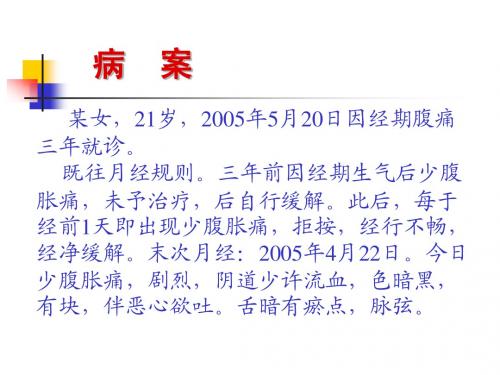
枳壳、乌药、香附、理气调肝止痛; 当归、川芎养血柔肝,调血止痛; 赤芍、桃仁、丹皮活血祛瘀; 延胡索、五灵脂止痛化瘀; 甘草调和诸药,缓急止痛。 共奏理气化瘀止痛之效。
若痛经剧烈,伴有恶心呕吐者,酌加吴茱萸、 半夏、陈皮; 若兼口苦,苔黄,月经持续时间延长,经色紫 黯,经质稠粘者,为肝郁化热之象,当佐以清 泄肝热,加栀子、夏枯草、仙鹤草; 兼寒者,小腹冷痛,酌加艾叶、小茴香。
历史沿革
《宋氏女科秘书· 经候不调门》:“经水将来作痛者, 血瘀气滞也,腹中阵阵作痛,乍作乍止,气血俱虚, 治当以行经顺气”,“经水行后作痛者,气血虚也, 治当调养气血”。 《傅青主女科· 调经》认为痛经有肝郁、寒湿、肾虚等 不同证类,当分别治以宣郁通经汤、温脐化湿汤、调 肝汤。 《医宗金鉴· 妇科心法要诀》:“经后腹痛当归建,经 前胀痛气为殃,加味乌药汤乌缩,延草木香香附榔。 血凝碍气疼过胀,《本事》琥珀散最良,棱莪丹桂延 乌药,寄奴当归芍地黄。”
病
案
某女,21岁,2005年5月20日因经期腹痛 三年就诊。 既往月经规则。三年前因经期生气后少腹 胀痛,未予治疗,后自行缓解。此后,每于 经前1天即出现少腹胀痛,拒按,经行不畅, 经净缓解。末次月经:2005年4月22日。今日 少腹胀痛,剧烈,阴道少许流血,色暗黑, 有块,伴恶心欲吐。舌暗有瘀点,脉弦。
诊
断
病史 有经行腹痛史;或有精神过度紧张,经期产后冒雨涉水、 过食寒凉,或有不节房事等情况;盆腔炎病史及妇科手术史等。 症状 检查 1.妇科检查 功能性痛经者多无明显病变,部分患者可有子宫 体极度屈曲,宫颈口狭窄。内异症患者多有痛性 结节,子宫粘连、活动受限,或伴有卵巢囊肿; 子宫腺肌症患者子宫多均匀增大,经期检查时子 宫压痛明显;慢性盆腔炎者有盆腔炎症的征象。 2.其他检查 盆腔B超检查对子宫内膜异位症、子宫腺肌症、慢 性盆腔炎的诊断有帮助,必要时行腹腔镜检查。
基于文献研究与专家共识法的原发性痛经中医证候研究
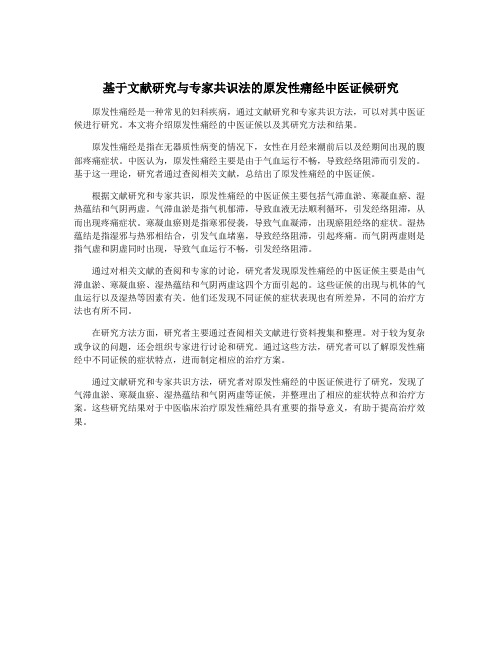
基于文献研究与专家共识法的原发性痛经中医证候研究原发性痛经是一种常见的妇科疾病,通过文献研究和专家共识方法,可以对其中医证候进行研究。
本文将介绍原发性痛经的中医证候以及其研究方法和结果。
原发性痛经是指在无器质性病变的情况下,女性在月经来潮前后以及经期间出现的腹部疼痛症状。
中医认为,原发性痛经主要是由于气血运行不畅,导致经络阻滞而引发的。
基于这一理论,研究者通过查阅相关文献,总结出了原发性痛经的中医证候。
根据文献研究和专家共识,原发性痛经的中医证候主要包括气滞血淤、寒凝血瘀、湿热蕴结和气阴两虚。
气滞血淤是指气机郁滞,导致血液无法顺利循环,引发经络阻滞,从而出现疼痛症状。
寒凝血瘀则是指寒邪侵袭,导致气血凝滞,出现瘀阻经络的症状。
湿热蕴结是指湿邪与热邪相结合,引发气血堵塞,导致经络阻滞,引起疼痛。
而气阴两虚则是指气虚和阴虚同时出现,导致气血运行不畅,引发经络阻滞。
通过对相关文献的查阅和专家的讨论,研究者发现原发性痛经的中医证候主要是由气滞血淤、寒凝血瘀、湿热蕴结和气阴两虚这四个方面引起的。
这些证候的出现与机体的气血运行以及湿热等因素有关。
他们还发现不同证候的症状表现也有所差异,不同的治疗方法也有所不同。
在研究方法方面,研究者主要通过查阅相关文献进行资料搜集和整理。
对于较为复杂或争议的问题,还会组织专家进行讨论和研究。
通过这些方法,研究者可以了解原发性痛经中不同证候的症状特点,进而制定相应的治疗方案。
通过文献研究和专家共识方法,研究者对原发性痛经的中医证候进行了研究,发现了气滞血淤、寒凝血瘀、湿热蕴结和气阴两虚等证候,并整理出了相应的症状特点和治疗方案。
这些研究结果对于中医临床治疗原发性痛经具有重要的指导意义,有助于提高治疗效果。
基于文献研究与专家共识法的原发性痛经中医证候研究
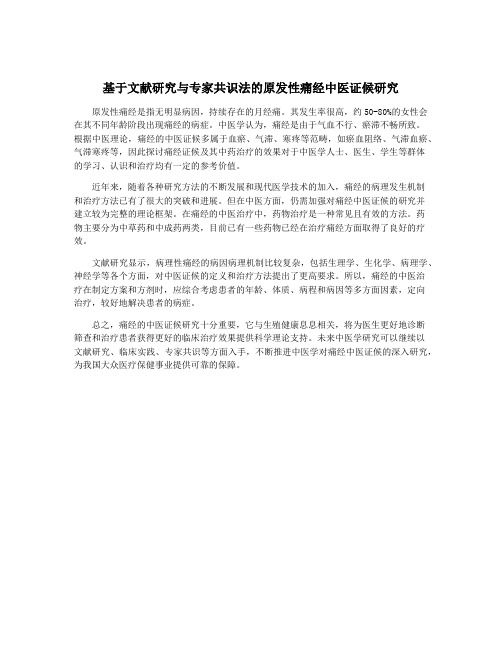
基于文献研究与专家共识法的原发性痛经中医证候研究
原发性痛经是指无明显病因,持续存在的月经痛。
其发生率很高,约50-80%的女性会在其不同年龄阶段出现痛经的病症。
中医学认为,痛经是由于气血不行、瘀滞不畅所致。
根据中医理论,痛经的中医证候多属于血瘀、气滞、寒疼等范畴,如瘀血阻络、气滞血瘀、气滞寒疼等,因此探讨痛经证候及其中药治疗的效果对于中医学人士、医生、学生等群体
的学习、认识和治疗均有一定的参考价值。
近年来,随着各种研究方法的不断发展和现代医学技术的加入,痛经的病理发生机制
和治疗方法已有了很大的突破和进展。
但在中医方面,仍需加强对痛经中医证候的研究并
建立较为完整的理论框架。
在痛经的中医治疗中,药物治疗是一种常见且有效的方法。
药
物主要分为中草药和中成药两类,目前已有一些药物已经在治疗痛经方面取得了良好的疗效。
文献研究显示,病理性痛经的病因病理机制比较复杂,包括生理学、生化学、病理学、神经学等各个方面,对中医证候的定义和治疗方法提出了更高要求。
所以,痛经的中医治
疗在制定方案和方剂时,应综合考虑患者的年龄、体质、病程和病因等多方面因素,定向
治疗,较好地解决患者的病症。
总之,痛经的中医证候研究十分重要,它与生殖健康息息相关,将为医生更好地诊断
筛查和治疗患者获得更好的临床治疗效果提供科学理论支持。
未来中医学研究可以继续以
文献研究、临床实践、专家共识等方面入手,不断推进中医学对痛经中医证候的深入研究,为我国大众医疗保健事业提供可靠的保障。
基于文献研究与专家共识法的原发性痛经中医证候研究
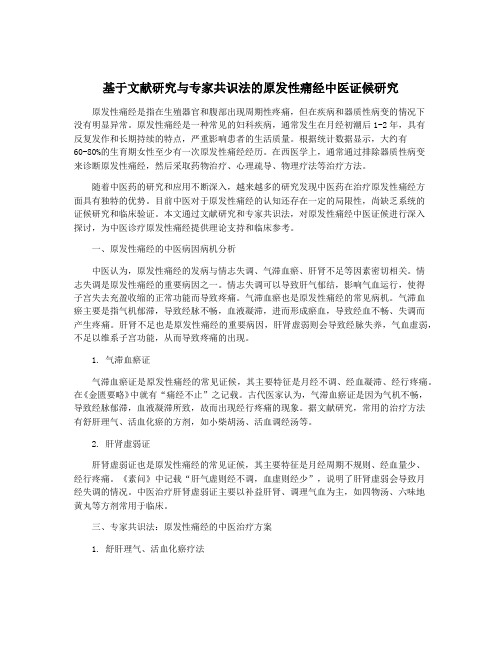
基于文献研究与专家共识法的原发性痛经中医证候研究原发性痛经是指在生殖器官和腹部出现周期性疼痛,但在疾病和器质性病变的情况下没有明显异常。
原发性痛经是一种常见的妇科疾病,通常发生在月经初潮后1-2年,具有反复发作和长期持续的特点,严重影响患者的生活质量。
根据统计数据显示,大约有60-80%的生育期女性至少有一次原发性痛经经历。
在西医学上,通常通过排除器质性病变来诊断原发性痛经,然后采取药物治疗、心理疏导、物理疗法等治疗方法。
随着中医药的研究和应用不断深入,越来越多的研究发现中医药在治疗原发性痛经方面具有独特的优势。
目前中医对于原发性痛经的认知还存在一定的局限性,尚缺乏系统的证候研究和临床验证。
本文通过文献研究和专家共识法,对原发性痛经中医证候进行深入探讨,为中医诊疗原发性痛经提供理论支持和临床参考。
一、原发性痛经的中医病因病机分析中医认为,原发性痛经的发病与情志失调、气滞血瘀、肝肾不足等因素密切相关。
情志失调是原发性痛经的重要病因之一。
情志失调可以导致肝气郁结,影响气血运行,使得子宫失去充盈收缩的正常功能而导致疼痛。
气滞血瘀也是原发性痛经的常见病机。
气滞血瘀主要是指气机郁滞,导致经脉不畅,血液凝滞,进而形成瘀血,导致经血不畅、失调而产生疼痛。
肝肾不足也是原发性痛经的重要病因,肝肾虚弱则会导致经脉失养,气血虚弱,不足以维系子宫功能,从而导致疼痛的出现。
1. 气滞血瘀证气滞血瘀证是原发性痛经的常见证候,其主要特征是月经不调、经血凝滞、经行疼痛。
在《金匮要略》中就有“痛经不止”之记载。
古代医家认为,气滞血瘀证是因为气机不畅,导致经脉郁滞,血液凝滞所致,故而出现经行疼痛的现象。
据文献研究,常用的治疗方法有舒肝理气、活血化瘀的方剂,如小柴胡汤、活血调经汤等。
2. 肝肾虚弱证肝肾虚弱证也是原发性痛经的常见证候,其主要特征是月经周期不规则、经血量少、经行疼痛。
《素问》中记载“肝气虚则经不调,血虚则经少”,说明了肝肾虚弱会导致月经失调的情况。
非药物方法治疗原发性痛经的新进展
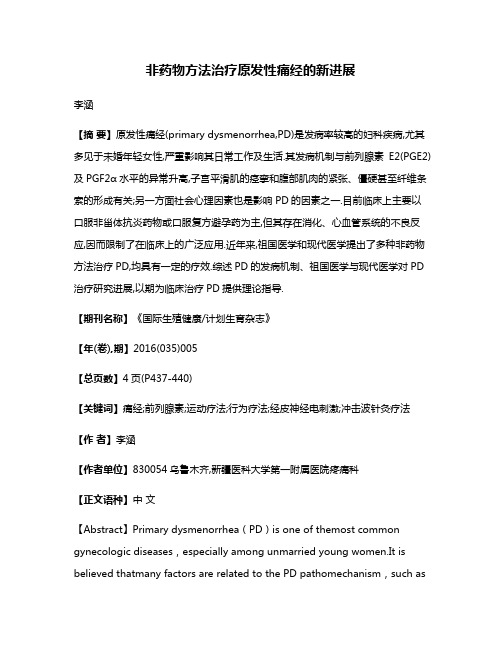
非药物方法治疗原发性痛经的新进展李涵【摘要】原发性痛经(primary dysmenorrhea,PD)是发病率较高的妇科疾病,尤其多见于未婚年轻女性,严重影响其日常工作及生活.其发病机制与前列腺素E2(PGE2)及PGF2α水平的异常升高,子宫平滑肌的痉挛和腹部肌肉的紧张、僵硬甚至纤维条索的形成有关;另一方面社会心理因素也是影响PD的因素之一.目前临床上主要以口服非甾体抗炎药物或口服复方避孕药为主,但其存在消化、心血管系统的不良反应,因而限制了在临床上的广泛应用.近年来,祖国医学和现代医学提出了多种非药物方法治疗PD,均具有一定的疗效.综述PD的发病机制、祖国医学与现代医学对PD 治疗研究进展,以期为临床治疗PD提供理论指导.【期刊名称】《国际生殖健康/计划生育杂志》【年(卷),期】2016(035)005【总页数】4页(P437-440)【关键词】痛经;前列腺素;运动疗法;行为疗法;经皮神经电刺激;冲击波针灸疗法【作者】李涵【作者单位】830054乌鲁木齐,新疆医科大学第一附属医院疼痛科【正文语种】中文【Abstract】Primary dysmenorrhea(PD)is one of themost common gynecologic diseases,especially among unmarried young women.It is believed thatmany factors are related to the PD pathomechanism,such asthe abnormally elevated levels of prostaglandin E2and F2α,the spasm of uterine smooth muscle,the tension and stiffness of abdominalmuscle,the formation of fibrous cords,and even the social psychological factors.Currently,the oral non-steroidal anti-inflammatory drugs or the combined oral contraceptive pills are themain treatment for PD.However,the adverse reactions in digestion and cardiovascular system affected their clinical application. Chinese traditionalmedicine and modern westernmedicine developed many kinds of non-pharmacologicalmethods for PD treatment.The research progress of those non-pharmacological treatment of PD,Chinese traditional medicine and modern western medicine,were introduced so as to provide a reference for the clinical practice.【Keywords】Dysmenorrhea;Prostaglandins;Exercise therapy;Behavior therapy;Transcutaneous electric nerve stimulation;Acupuncture-moxibustion痛经(dysmenorrhea)是指女性经期时的痛性痉挛[1],表现为周期性下腹、腰及盆底剧烈痉挛性疼痛,可放射至背部及股内侧,亦可伴有恶心、呕吐、四肢冰冷。
1.原发性痛经中医诊疗方案

国家中医药管理局要点专科协作组原发性痛经中医诊断方案一、诊断(一)疾病诊断1. 中医诊断标准:参照全国高等中医药院校规划教材《中医妇科学》(张玉珍主编,中国中医药第一版社, 2007 年),《中药新药临床研究指导原则》(卫生部公布, 2002年版)。
(1)病史:陪伴月经周期规律性发生的以小腹痛苦为主证史。
(2)临床表现:腹痛多发生在经前1-2 天,行经第 1 天达顶峰,可呈阵发性、痉挛性,或胀痛伴下坠感,严重者可放射到腰骶部、肛门、阴道、股内侧;甚至可见面无人色、出盗汗、手足发凉等,一般不伴有腹肌紧张或反跳痛。
(3)妇科检查:无阳性体征。
2. 西医诊断标准:参照《妇产科学》第七版(乐杰主编,人民卫生第一版社,2009年)(1)病史:陪伴月经周期规律发生的下腹部痛苦史。
(2)临床表现:①青春期常见,常在初潮后1-2 年内发病;②痛苦最早出此刻经前12 小时,以行经第1 日痛苦最强烈,连续2-3 天后缓解,痛苦常呈痉挛性,往常位于下腹部耻骨上,可放射至腰骶部和大腿内侧;③可伴有恶心、呕吐、腹泻、头晕、乏力等症状,严重时面色发白、出盗汗。
(3)妇科检查:清除生殖器官器质性疾病。
(二)证候诊断1.寒凝血瘀证主症:①经前或经期小腹冷痛拒按,得热痛减;②经血有瘀块。
次症:①经色紫黯;②月经推后或量少;③面色青白;④肢冷畏寒。
舌脉:舌质黯,或有瘀斑、瘀点,苔白,脉沉紧。
2.气滞血瘀证主症:①经前或经期小腹胀痛拒按;②经血有瘀块,块下痛暂减。
次症:①经色紫黯;②经血量少,行而不畅;③经前乳房胀痛;④胸闷不舒;⑤心烦易怒。
舌脉:舌质紫黯,或有瘀斑、瘀点,脉弦。
3.湿热瘀阻证主症:①经前或经期小腹胀痛或灼痛;②经色暗红,质稠或夹许多粘液。
次症:①月经量多或经期延伸;②向来带下量多,色黄质稠有臭味;③低热起伏;④小便黄赤。
舌脉:舌质红,苔黄腻,脉滑数或弦数。
4.肾气亏虚证主症:①经期或经后1-2 天内小腹绵绵作痛;②腰骶酸痛。
基于文献研究与专家共识法的原发性痛经中医证候研究
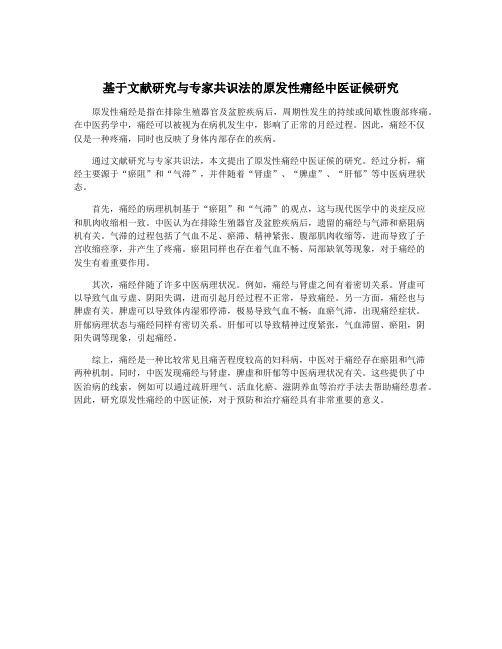
基于文献研究与专家共识法的原发性痛经中医证候研究原发性痛经是指在排除生殖器官及盆腔疾病后,周期性发生的持续或间歇性腹部疼痛。
在中医药学中,痛经可以被视为在病机发生中,影响了正常的月经过程。
因此,痛经不仅仅是一种疼痛,同时也反映了身体内部存在的疾病。
通过文献研究与专家共识法,本文提出了原发性痛经中医证候的研究。
经过分析,痛经主要源于“瘀阻”和“气滞”,并伴随着“肾虚”、“脾虚”、“肝郁”等中医病理状态。
首先,痛经的病理机制基于“瘀阻”和“气滞”的观点,这与现代医学中的炎症反应和肌肉收缩相一致。
中医认为在排除生殖器官及盆腔疾病后,遗留的痛经与气滞和瘀阻病机有关。
气滞的过程包括了气血不足、瘀滞、精神紧张、腹部肌肉收缩等,进而导致了子宫收缩痉挛,并产生了疼痛。
瘀阻同样也存在着气血不畅、局部缺氧等现象,对于痛经的发生有着重要作用。
其次,痛经伴随了许多中医病理状况。
例如,痛经与肾虚之间有着密切关系。
肾虚可以导致气血亏虚、阴阳失调,进而引起月经过程不正常,导致痛经。
另一方面,痛经也与脾虚有关。
脾虚可以导致体内湿邪停滞,极易导致气血不畅,血瘀气滞,出现痛经症状。
肝郁病理状态与痛经同样有密切关系。
肝郁可以导致精神过度紧张,气血滞留、瘀阻,阴阳失调等现象,引起痛经。
综上,痛经是一种比较常见且痛苦程度较高的妇科病,中医对于痛经存在瘀阻和气滞两种机制。
同时,中医发现痛经与肾虚,脾虚和肝郁等中医病理状况有关。
这些提供了中医治病的线索,例如可以通过疏肝理气、活血化瘀、滋阴养血等治疗手法去帮助痛经患者。
因此,研究原发性痛经的中医证候,对于预防和治疗痛经具有非常重要的意义。
原发性痛经中特殊群体的中医疗法
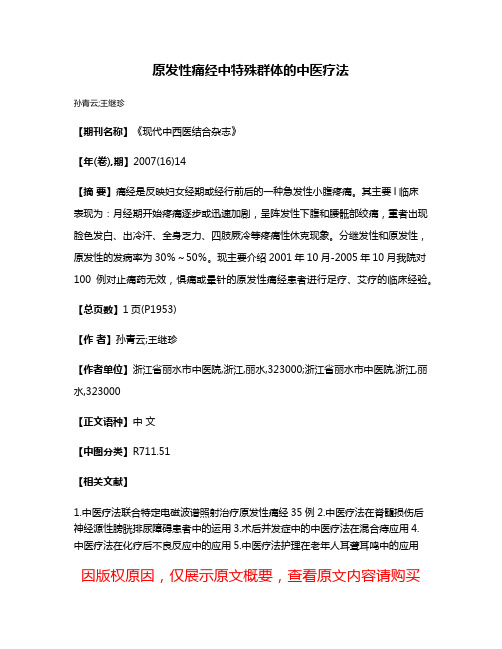
原发性痛经中特殊群体的中医疗法
孙青云;王继珍
【期刊名称】《现代中西医结合杂志》
【年(卷),期】2007(16)14
【摘要】痛经是反映妇女经期或经行前后的一种急发性小腹疼痛。
其主要l临床
表现为:月经期开始疼痛逐步或迅速加剧,呈阵发性下腹和腰骶部绞痛,重者出现脸色发白、出冷汗、全身乏力、四肢厥冷等疼痛性休克现象。
分继发性和原发性,原发性的发病率为30%~50%。
现主要介绍2001年10月-2005年10月我院对100例对止痛药无效,惧痛或晕针的原发性痛经患者进行足疗、艾疗的临床经验。
【总页数】1页(P1953)
【作者】孙青云;王继珍
【作者单位】浙江省丽水市中医院,浙江,丽水,323000;浙江省丽水市中医院,浙江,丽水,323000
【正文语种】中文
【中图分类】R711.51
【相关文献】
1.中医疗法联合特定电磁波谱照射治疗原发性痛经35例
2.中医疗法在脊髓损伤后神经源性膀胱排尿障碍患者中的运用
3.术后并发症中的中医疗法在混合痔应用
4.
中医疗法在化疗后不良反应中的应用5.中医疗法护理在老年人耳聋耳鸣中的应用因版权原因,仅展示原文概要,查看原文内容请购买。
中西药配伍治疗原发性痛经
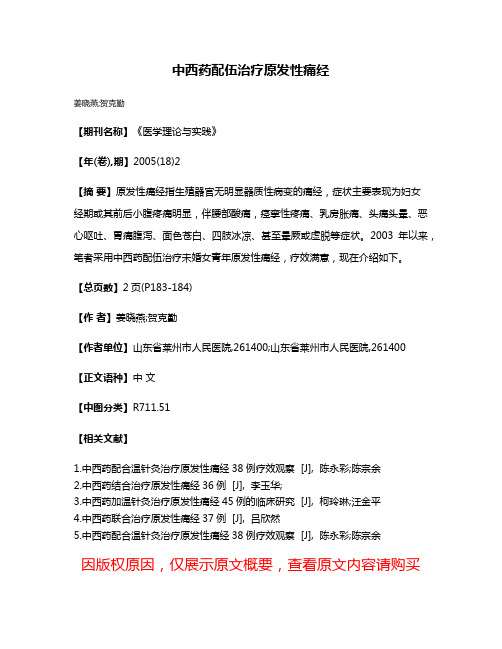
中西药配伍治疗原发性痛经
姜晓燕;贺克勤
【期刊名称】《医学理论与实践》
【年(卷),期】2005(18)2
【摘要】原发性痛经指生殖器官无明显器质性病变的痛经,症状主要表现为妇女
经期或其前后小腹疼痛明显,伴腰部酸痛,痉挛性疼痛、乳房胀痛、头痛头晕、恶心呕吐、胃痛腹泻、面色苍白、四肢冰凉、甚至晕厥或虚脱等症状。
2003年以来,笔者采用中西药配伍治疗未婚女青年原发性痛经,疗效满意,现在介绍如下。
【总页数】2页(P183-184)
【作者】姜晓燕;贺克勤
【作者单位】山东省莱州市人民医院,261400;山东省莱州市人民医院,261400
【正文语种】中文
【中图分类】R711.51
【相关文献】
1.中西药配合温针灸治疗原发性痛经38例疗效观察 [J], 陈永彩;陈宗余
2.中西药结合治疗原发性痛经36例 [J], 李玉华;
3.中西药加温针灸治疗原发性痛经45例的临床研究 [J], 柯玲琳;汪金平
4.中西药联合治疗原发性痛经37例 [J], 吕欣然
5.中西药配合温针灸治疗原发性痛经38例疗效观察 [J], 陈永彩;陈宗余
因版权原因,仅展示原文概要,查看原文内容请购买。
- 1、下载文档前请自行甄别文档内容的完整性,平台不提供额外的编辑、内容补充、找答案等附加服务。
- 2、"仅部分预览"的文档,不可在线预览部分如存在完整性等问题,可反馈申请退款(可完整预览的文档不适用该条件!)。
- 3、如文档侵犯您的权益,请联系客服反馈,我们会尽快为您处理(人工客服工作时间:9:00-18:30)。
Primary Dysmenorrhea Consensus GuidelineAbstractMethods:Members of this consensus group were selected based on individual expertise to represent a range of practical and academic experience both in terms of location in Canada and type ofpractice,as well as subspecialty expertise along with generalgynaecology backgrounds.The consensus group reviewed allavailable evidence through the English and French medicalliterature and available data from a survey of Canadian women.Recommendations were established as consensus statements.The final document was reviewed and approved by the Executive and Council of the SOGC.Results:This document provides a summary of up-to-date evidence regarding the diagnosis,investigations,and medical and surgical management of dysmenorrhea.The resulting recommendations may be adapted by individual health care workers when serving women who suffer from this condition.Conclusions:Dysmenorrhea is an extremely common and sometimes debilitating condition for women of reproductive age.A multidisciplinary approach involving a combination of lifestyle,medications,and allied health services should be used to limit the impact of this condition on activities of daily living.In somecircumstances,surgery is required to offer the desired relief. Outcomes:This guideline discusses the various options in managing dysmenorrhea.Patient information materials may be derived from these guidelines in order to educate women in terms of theiroptions and possible risks and benefits of various treatmentstrategies.Women who find an acceptable management strategy for this condition may benefit from an improved quality of life.Evidence:MEDLINE and Cochrane databases were searched for articles in English and French on subjects related to primarydysmenorrhea,menstrual pain and pelvic pain from January1990 to December2004in order to prepare a Canadian consensusguideline on the management of primary dysmenorrhea.Values:The quality of evidence is rated using the criteria described in the Report of the Canadian Task Force on the Periodic HealthExamination.Recommendations for practice are ranked according to this method.Sponsors:The development of this consensus guideline was supported by unrestricted educational grants from Pfizer Canada Inc.,Janssen-Ortho,Wyeth,Organon Canada Ltd.,and BerlexCanada Inc.RecommendationsSection3:Diagnosis/Differential Diagnosis/Investigations1.In adolescents experiencing dysmenorrhea in the first6monthsfrom the start of menarche,and when an anovulatory patientcomplains of dysmenorrhea,the diagnosis of obstructingmalformation of the genital tract should be considered.(III-A)2.The diagnosis of secondary dysmenorrhea should be consideredwhen symptoms appear after many years of painless menses.(III-A)3.In view of the high prevalence of dysmenorrhea,and evidence thatmany women do not seek medical attention for this problem,health care providers should include specific questions regardingmenstrual pain when obtaining a womanÆ's medical history.(III-B) 4.In an adolescent who has never been sexually active and has atypical history of mild to moderate dysmenorrhea,a pelvicexamination is not necessary.(III-D)5.A pelvic examination is indicated in all patients not responding toconventional therapy of dysmenorrhea or when an organicpathology is suspected.(III-B)Section4:Non-medicinal Therapeutic Options1.Unlike low-frequency TENS,high-frequency TENS provides moreeffective dysmenorrhea pain relief compared with placebo.High-frequency TENS may be considered as a supplementarytreatment in women unable to tolerate medication.(II-B)2.Women who inquire about alternatives to relieve dysmenorrhea,may be instructed that,at the present time,there is limitedevidence that acupuncture may be of benefit(II-B),there is noevidence to support spinal manipulation as an effective treatment (II-D),and there is limited evidence to support topical heat therapy(II-B). Section5:Medicinal Therapeutic Options1.Women suffering from primary dysmenorrhea should be offeredNSAIDs as a first-line treatment for the relief of pain and improved daily activity unless they have a contraindication to the use ofNSAIDs.(I-A)DECEMBER JOGC DÉCEMBRE2005l1117CO-CHAIRSGuylaine Lefebvre,MD,FRCSC,Ottawa ONOdette Pinsonneault,MD,FRCSC,Sherbrooke QCCO-AUTHORSViola Antao,MD,CCFP,MHSc,Toronto ONAmanda Black,MD,FRCSC,Ottawa ONMargaret Burnett,MD,MA,CCFP,FRCSC,Winnipeg MBKymm Feldman,MD,CCFP,MHSc,Toronto ONRobert Lea,MD,FRCSC,Halifax NSMagali Robert,MD,FRCSC,Calgary ABNo169,December20052.Oral contraceptives may be recommended for the treatment of primary dysmenorrhea.The added contraceptive advantage may make oral contraceptives a first-line therapy for some women.(1-A)3.Consideration may be given to continuous use of oral contraceptive pills for withdrawal bleeding and the associated dysmenorrhea.(1-A)4.Depot medroxyprogesterone acetate and levonorgestrel intrauterine system have been shown to be effective in thetreatment of dysmenorrhea and therefore can be considered as treatment options in the management of primary dysmenorrhea.(II-B)Section 6:Surgical Options1.Surgery constitutes the final diagnostic and therapeutic option in the management of paroscopy should beconsidered in women who have persistent dysmenorrhea despite medical therapy of NSAIDs and/or oral contraceptives.(III-C)2.Hysterectomy may be considered for the management ofdysmenorrhea when medical alternatives have been refused or failed and fertility is no longer possible or desired.(II-B)3.As there is limited evidence for use of presacral neurectomy in the management of primary dysmenorrhea,the risks must be carefully weighed against the expected benefits.(III-C)paroscopic uterosacral ligament resection has not been shown to reduce dysmenorrhea and therefore should not be advocated as a mainstream treatment option.(III-C)Section 7:Complementary and Alternative Medicine (CAM)1.The following CAM has limited support and may be considered in the treatment of primary dysmenorrhea,though further study is required:•Vitamin B1(I-B)2.The following CAMs showed an initial positive response for the treatment of primary dysmenorrhea and merit further study:•Vitamin E (I-C)•Fish oil /Vitamin B12combination (I-C)•Magnesium (II-1C)•Vitamin B6;(II-1C)•Toki-shakuyaku-san (II-1C)•Fish oil (II-3C)•Neptune krill oil (II-3C)3.The following CAMs have not been shown to have any benefit in the treatment of primary dysmenorrhea and may need further study:•Vitamin B6/Magnesium combination (II-1)•Vitamin E (daily)in addition to Ibuprofen (during menses)(II-3)•Fennel (II-3)J Obstet Gynaecol Can 2005;27(12):1117–1130SECTION 1:DEFINITION AND PATHOPHYSIOLOGY“Dysmenorrhea”is derived from a Greek root translating to difficult menstrual flow.Dysmenorrhea can be divided into 2broad categories of primary and secondary.Primary dysmenorrhea is defined as recurrent,crampy pain occur-ring with menses in the absence of identifiable pelvic pathology.Secondary dysmenorrhea is menstrual pain associated with underlying pelvic pathology such as endometriosis.Primary dysmenorrhea usually begins in adolescence after the establishment of ovulatory cycles.1,2Primary dysmenorrhea is caused by myometrial activity resulting in uterine ischemia causing pain.1This myometrial activity is modulated and augmented by prostaglandin synthesis (Figure 1).Uterine contractions can last many minutes and may produce uterine pressures greater than 60mm Hg.Multiple other factors may play a role in the perception and the severity of the pain.SOGC CLINICAL PRACTICE GUIDELINE1118l DECEMBER JOGC DÉCEMBRE 2005Table 1.Criteria for quality of evidence assessment and classification of recommendationsLevel of evidence*Classification of recommendations†I:Evidence obtained from at least one properly designed randomized controlled trial.II-1:Evidence from well-designed controlled trials withoutrandomization.II-2:Evidence from well-designed cohort (prospective orretrospective)or case-control studies,preferably from more than one centre or research group.II-3:Evidence from comparisons between times or places withor without the intervention.Dramatic results fromuncontrolled experiments (such as the results of treatment with penicillin in the 1940s)could also be included in this category.III:Opinions of respected authorities,based on clinicalexperience,descriptive studies,or reports of expert committees.A.There is good evidence to support the recommendation foruse of a diagnostic test,treatment,or intervention.B.There is fair evidence to support the recommendation foruse of a diagnostic test,treatment,or intervention.C.There is insufficient evidence to support the recommen-dation for use of a diagnostic test,treatment,or inter-vention.D.There is fair evidence not to support the recommendationfor a diagnostic test,treatment,or intervention.E.There is good evidence not to support the recommendationfor use of a diagnostic test,treatment,or intervention.*The quality of evidence reported in these guidelines has been adapted from the Evaluation of Evidence criteria described in the Canadian Task Force on the Periodic Health Exam.126†Recommendations included in these guidelines have been adapted from the Classification of Recommendations criteria described in the Canadian Task Force on the Periodic Health Exam.126SECTION 2:RISK FACTORSDysmenorrhea is the most common gynaecological symp-tom reported by women.Ninety percent of women pre-senting for primary care suffer from some menstrual pain.3Population surveys suggest that,although prevalence rates vary considerably by geographical location,complaints of dysmenorrhea are widespread in diverse populations.4–10Furthermore,one third to one half of these women report moderate or severe symptoms.Symptoms are frequently associated with time lost from school,work,or other activi-ties.11In spite of the frequency and severity of dysmenorrhea,most women do not seek medical treatment for this condition.4,12Age is a determinant of menstrual pain 12with symptoms being more pronounced in adolescents than in older women.9,12,13Associated factors for more severe episodes of dysmenorrhea may include early menarche,6,14,15heavyand increased duration of menstrual flow 14,15and family his-tory.15There is some evidence that parous women have less severe dysmenorrhea.6,13,14,16The evidence that smoking worsens primary menstrual pain is convincing.12,13,15–17One recent prospective study found that dysmenorrhea is also associated with increased expo-sure to environmental tobacco smoke.18There is some suggestion that more frequent life changes,fewer social supports,and stressful close relationships may be associated with increased dysmenorrhea.19There may be an increased prevalence of dysmenorrhea in lower socioeconomic groups.3There is controversy about the association of obesity,6,14,17physical activity,14,17and alcohol 6,14,16,17with primary dysmenorrhea.SECTION 3:DIAGNOSIS /DIFFERENTIAL DIAGNOSIS /INVESTIGATIONSDIAGNOSIS OF PRIMARY DYSMENORRHEATypically,primary dysmenorrhea is characterized by a crampy suprapubic pain that begins somewhere between several hours before and a few hours after the onset of the menstrual bleeding.Symptoms peak with maximum blood flow 20and usually last less than one day,but the pain may persist up to 2to 3days.Symptoms are more or less repro-ducible from one menstrual period to the other.21The pain is characteristically colicky and located in the midline of thelower abdomen but may also be described as dull and may extend to both lower quadrants,the lumbar area,and the thighs.Frequently associated symptoms include diarrhea,nausea and vomiting,fatigue,light-headedness,headache,dizziness and,rarely,syncope and fever.20,22–25These asso-ciated symptoms have been attributed to prostaglandin release.1,2Onset of dysmenorrhea soon after menarche or in a patient who is clearly anovulatory should alert the physician to thePrimary Dysmenorrhea Consensus GuidelineDECEMBER JOGC DÉCEMBRE 2005l1119Figure 1.Pathophysiology of primary dysmenorrheapossibility of an obstructing malformation of the genital tract.Occasionally adolescents may experience menstrual pain with their first periods without any demonstrable underlying cause,especially when the bleeding is heavy and accompanied by clots.22Menstrual pain appearing after several years of painless periods is suggestive of secondary dysmenorrhea.Differential diagnosisThe differential diagnosis of primary dysmenorrhea is sum-marized in Table2.Endometriosis is certainly one of the most frequent causes of secondary dysmenorrhea and is a disease that can also affect younger patients.In adolescent girls undergoing laparoscopy for chronic pelvic pain not responding to NSAIDs and oral contraceptives, endometriosis is found with a prevalence of approximately 70%.26,27In parous women,adenomyosis should be con-sidered as a possible diagnosis,especially in the presence of menorrhagia and of a uniformly enlarged uterus. Pedunculated submucosal leiomyomas and endometrial polyps may cause obstruction of the cervical canal and trig-ger painful menstrual cramps.In patients with a history of surgical procedures of the cervix such as a cerclage,a cryotherapy,or a conization,cervical stenosis is a possibil-ity.When dysmenorrhea occurs suddenly in patients who normally have no or mild menstrual pain,pelvic inflamma-tory disease or pregnancy complications should be ruled out.Congenital obstructing malformations of the müllerian ducts should be considered when dysmenorrhea appears before the establishment of ovulatory menstrual cycles.21,24 Other causes of chronic pelvic pain(chronic pelvic inflam-matory disease,pelvic adhesions,bowel inflammatory dis-eases,irritable bowel syndrome,interstitial cystitis)may be symptomatic during menses.28CLINICAL APPROACHHistoryMany women consider menstrual pain,even severe and incapacitating,as inevitable.Women suffering from pri-mary dysmenorrhea may not seek medical assistance and frequently do not make use of the prescription therapies that are available.12,22When a health care provider identifies menstrual pain on history,an attempt should then be made to differentiate between primary and secondary dysmenorrhea.The history should focus on menstrual history,including age at menar-che,length and regularity of cycles,dates of last two menses,and duration and amount of the bleeding.The length of time elapsed between menarche and the beginning of dysmenorrhea should be established.The pain should be clearly defined in terms of type,location,radiation,and associated symptoms,as well as the chronology of the onset of pain in relation to onset of menstrual bleeding.The severity and duration of symptoms,the progression over time,and the degree of the patient’s disability should be established.Significant gastrointestinal or urinary symp-toms or the presence of pelvic pain not related to the men-strual cycle may suggest other causes of pelvic pain.In obtaining a thorough history,it is important to inquire about sexual activity,dyspareunia,and contraception.Many adolescents use dysmenorrhea as a pretext to obtain contraception.24Past obstetric and gynaecologic history,in particular,sexually transmitted infections,pelvic infection, infertility,and pelvic surgery,as well as other medical prob-lems should be recorded.A family history of endometriosis should also be sought.The patient should also be asked about all types of therapy tried in the past.Since many patients do not use medication in adequate dose,it is essential to inquire about the way every medication was utilized.Campbell and McGrath report that in a group of high school girls aged14to 21years using over-the-counter medications for menstrual discomfort,only31%took them at the recommended daily dosage.Of those using a prescription drug,13%reported using less than the prescribed dose.In the same study,par-ticipants waited a median of30minutes after the onset of dysmenorrhea before taking their medication and only16% of them took it prophylactically.29Many patients who state that oral contraceptives are ineffective did not try them for a long enough period to obtain the maximum effectiveness in pain relief.PHYSICAL EXAMINATIONWomen suffering from primary dysmenorrhea are expected to have a normal pelvic examination.However,a normal pelvic examination does not systematically rule out the presence of a pelvic pathology.An abdominal examination should be done in every patient to rule out palpable pathology.In an adolescent who has never been sexually active and presents with a typical his-tory of mild to moderate primary dysmenorrhea,pelvic examination is not necessary.21,22–24However,some authors recommend inspecting the external genitalia of all patients to exclude an abnormality of the hymen.23On the other hand,when history is suggestive of organic disease or con-genital malformation of the genital tract,or when the patient does not respond to the conventional therapy of pri-mary dysmenorrhea,a complete pelvic examination is indicated.SOGC CLINICAL PRACTICE GUIDELINE 1120l DECEMBER JOGC DÉCEMBRE2005INVESTIGATIONSLaboratory testing or imaging is not required to make a diagnosis of primary plementary inves-tigations may be ordered when secondary dysmenorrhea is suspected.There is no evidence for the routine use of ultrasound in the evaluation of primary dysmenorrhea.For women who suf-fer from dysmenorrhea refractory to first-line therapy,or in women who have a clinical abnormality on pelvic examina-tion,ultrasound may identify causes of secondary dys-menorrhea.In adolescents in whom a pelvic examination is impossible or unsatisfactory,ultrasound may uncover a pelvic mass or an obstructing müllerian malformation. Ultrasonography cannot detect subtle signs of organic dis-eases such as uterosacral ligament tenderness or nodules and cervical motion tenderness.Ultrasound will not replace a thorough bimanual examination.Magnetic resonance imaging has been shown to be an inter-esting diagnostic tool for adenomyosis but since a precise diagnosis of this pathology is rarely essential to therapeutic decisions,this expensive test has limited clinical usefulness.28,30Hysteroscopy and saline sonohysterography are helpful in the diagnosis of endometrial polyps and submucosal leiomyomas.30,31Laparoscopy is the only procedure that will establish a defi-nite diagnosis of endometriosis,pelvic inflammatory dis-ease,or pelvic adhesions.It should be performed when these pathologies are strongly suspected or when first-line therapy has failed.In adolescent girls who do not respond to therapy,a diagnostic laparoscopy should not be post-poned unduly because the prognosis of endometriosis may be improved by an early diagnosis.32Gynaecologists are usually experienced with the laparoscopic diagnosis of endometriosis in adult women.In adolescents,however, the appearance of endometriotic implants may have vari-able morphology.In these younger patients,red flame, white,and clear lesions are more frequently seen than the classical blue-black and powder burn lesions found in adults.33Laufer has proposed that using fluid as a distension medium during laparoscopy facilitates the identification of clear lesions that can be easily missed when doing the con-ventional technique of laparoscopy.34This has not been advocated traditionally.Biopsies of visible lesions,espe-cially when atypical,are recommended in order to have histological confirmation of the diagnosis. Recommendations1.In adolescents experiencing dysmenorrhea in the first six months from the start of menarche,and when an anovulatory patient complains of dysmenorrhea,the diagnosis of obstructing malformation of the genital tract should be considered.(III-A)2.The diagnosis of secondary dysmenorrhea should be considered when symptoms appear after many years of painless menses.(III-A)3.In view of the high prevalence of dysmenorrhea,and evi-dence that many women do not seek medical attention for this problem,health care providers should include specific questions regarding menstrual pain when obtaining a woman’s medical history.(III-B)4.In an adolescent who has never been sexually active and has a typical history of mild to moderate dysmenorrhea,a pelvic examination is not necessary.(III-D)5.A pelvic examination is indicated in all patients not responding to conventional therapy of dysmenorrhea or when an organic pathology is suspected.(III-B)Primary Dysmenorrhea Consensus GuidelineDECEMBER JOGC DÉCEMBRE2005l1121Table2.Differential diagnosis of dysmenorrhea Primary dysmenorrheaSecondary dysmenorrheaEndometriosisAdenomyosisUterine myomasEndometrial polypsCervical stenosisObstructive malformations of the genital tractOther causes of painChronic pelvic inflammatory diseasePelvic adhesionsIrritable bowel syndromeInflammatory bowel diseaseInterstitial cystitisSudden onset of dysmenorrheaPelvic inflammatory diseaseUnrecognized ectopic pregnancy or spontaneous abortionSECTION4:NON-MEDICINAL THERAPEUTIC OPTIONSNon-medicinal approaches such as exercise,heat,behav-ioural interventions,and dietary/herbal supplements are commonly utilized by women in an effort to relieve dysmenorrhea.35The data on the effectiveness of such interventions remain inconclusive and controversial. EXERCISEIn a review of4randomized controlled trials and2observa-tional studies,exercise was associated with a reduction in dysmenorrhea symptoms.36A more recent study found that vigorous exercisers(more than3times per week) reported less physical symptoms during menstruation in comparison with sedentary counterparts.37In contrast, results from a retrospective questionnaire completed by a cohort of nurses indicated that although exercise was asso-ciated with an improvement in mood and stress,it was also associated with a30%increase in dysmenorrhea symptom severity.36,38The majority of these early studies had numer-ous methodological flaws(non-blinded,confounding fac-tors,lack of objective measurements for pain or level of activity),making it inappropriate to draw definitive conclu-sions regarding the use of exercise as a supplementary treat-ment for dysmenorrhea.A Cochrane review on exercise and primary dysmenorrhea is currently being compiled and recommendations are expected in2005.39 TRANSCUTANEOUS ELECTRICAL NERVE STIMULATION(TENS)/ACUPUNCTURETENS involves use of electrodes to stimulate the skin at various frequencies and intensities in an attempt to diminish pain perception.TENS may be divided into high and low frequency.Low-frequency TENS involves pulses delivered between1and4Hz and high-frequency TENS consists of pulses delivered between50and120Hz.40,41Acupuncture also involves stimulating nerve fibre receptors in an attempt to block pain impulses.A Cochrane review examined9ran-domized controlled trials on the use of TENS or acupunc-ture for the treatment of primary dysmenorrhea.42Overall data indicated that high-frequency TENS provides more effective pain relief when compared with placebo TENS.40,41,43Adverse outcomes associated with high-frequency TENS including muscle tightness,headaches, nausea,redness or burning of skin were reported in over 10%of participants.40Two trials compared TENS with medical treatment.Ibuprofen was found to be significantly better in relieving pain in comparison than high-frequency TENS.40In contrast,no difference in pain relief scores was demonstrated between naproxen and high-frequency TENS.41,44Overall results indicate no significant differ-ences between low-frequency TENS and placebo TENS or placebo pill for relief of dysmenorrhea.41,43,45–47 Significantly greater pain relief in the acupuncture group compared with the sham acupuncture group was reported.48Due to the limited evidence(only1randomized controlled trial),recommendations regarding acupuncture as a treatment for dysmenorrhea must be guarded.SPINAL MANIPULATIONA Cochrane review included5trials examining spinal manipulation for the treatment of dysmenorrhea.Overall results provided no evidence that spinal manipulation relieves dysmenorrhea.49No significant differences in adverse effects were reported by the spinal manipulation group in comparison to the sham treatment group.50 BEHAVIOURAL INTERVENTIONSBehavioural interventions used in the treatment of dysmenorrhea include procedures such as biofeedback, desensitization,Lamaze exercise,hypnotherapy,and relax-ation training.51Case studies suggest that behavioural inter-ventions may be effective in treating dysmenorrhea.51 Because of the limited studies no recommendation can be formulated at this time.A Cochrane protocol examining behavioural interventions for primary and secondary dysmenorrhea was published in2000,but has since been withdrawn from publication.52TOPICAL HEATA randomized placebo-controlled trial compared the effec-tiveness of topically applied heat for dysmenorrhea with the use of oral ibuprofen and placebo treatments.Results indicate that the3treatment groups–heated patch plus ibuprofen,heated patch plus placebo pill,and unheated patch plus ibuprofen–demonstrated significantly greater pain relief than the unheated patch plus placebo pill control (P<0.001).Low-level topical heat therapy was as effective as ibuprofen for the treatment of dysmenorrhea.Further-more,there was faster improvement in pain relief when heat was applied with ibuprofen compared with the ibuprofen and unheated patch control.53SOGC CLINICAL PRACTICE GUIDELINE 1122l DECEMBER JOGC DÉCEMBRE2005Recommendations1.Unlike low-frequency TENS,high-frequency TENS provides more effective dysmenorrhea pain relief than placebo.High-frequency TENS may be considered as a supplementary treatment in women unable to tolerate medication.(II-B)2.Women who inquire about alternatives to relieve dysmenorrhea may be instructed that,at the present time,there is limited evidence that acupuncture may be of benefit(II-B),there is no evidence to support spinal manipulation as an effective treatment(II-D),and there is limited evidence to support topical heat therapy.(II-B)SECTION5:MEDICINAL THERAPEUTIC OPTIONS5.1NON-HORMONAL MEDICAL TREATMENT Many drugs are commercially available and approved for the use in treatment of primary dysmenorrhea.Over-the-counter(OTC)medicationsOTC medications available to treat dysmenorrhea in Canada include acetaminophen(Tylenol),acetaminophen plus pamabrom(Midol),acetylsalicylic acid(Aspirin),and ibuprofen(Advil,Motrin).Acetaminophen is an analgesic/antipyretic drug,not a peripheral prostaglandin synthetase inhibitor,and is a weak cyclooxygenase(COX)inhibitor in the presence of high peroxide concentrations that are present in inflammatory tissues.Acetaminophen produces analgesia by raising the pain threshold.It is a safe drug when used in therapeutic dosages with a good gastrointestinal tolerance and no effect on hemostasis.Acetaminophen can cause liver damage after three or more alcoholic drinks per day54and can cross-react with ASA to produce analgesic-induced asthma.55The one randomized controlled trial of acetaminophen showed it to be no better than placebo,but the trial was small and also failed to show aspirin to be effec-tive.56In many analyses of effectiveness of medications for relief of primary dysmenorrhea,acetaminophen is used as the control.Acetaminophen and pamabrom are indicated to provide temporary relief of dysmenorrhea.Pamabrom is a mild and short-acting diuretic that relieves water retention.The avail-able information concerning the efficacy of acetaminophen in primary dysmenorrhea is limited and not conclusive with respect to other non-steroidal anti-inflammatory drugs (NSAIDs)or even placebo.The clinical evidence regarding the association with pamabrom is even more scarce.57 Adolescents who experience less menstrual discomfort, shorter duration of menstrual discomfort,and less severe disability were more likely to be associated with the use of OTC medications.More than half(56%)of the adolescents who used OTC medications took the pills less often than the maximum daily recommendation.29There was a greater frequency of OTC medication use among young women aged16to21years than among girls aged12to14years.58 NSAIDsNon-selective NSAIDsResearch has identified the over-production of uterine prostaglandins(higher levels of prostaglandins F2a and E2) as a contributing factor to primary dysmenorrhoea. NSAIDs are analgesics which inhibit the cyclooxygenase (COX)enzymes,thereby inhibiting the production of prostaglandins.A meta-analysis of56trials59confirms beyond doubt that all 4NSAIDs evaluated(naproxen,ibuprofen,mefenamic acid and aspirin)are effective in primary dysmenorrhea.In the systematic review,both naproxen and ibuprofen appeared to be better than aspirin.On a risk-benefit assessment, ibuprofen was better than naproxen because of the side effects of naproxen.All4NSAIDs reduced restriction of daily life better than placebo,but only with ibuprofen and naproxen was this statistically significant.In a review of63randomized controlled trials60in women with primary dysmenorrhea,NSAIDs were found signifi-cantly more effective for pain relief than placebo(OR7.91; 95%CI5.65–11.09),although overall adverse effects were also significantly more common(OR 1.52;95%CI 1.09–2.12).When NSAIDs were compared with each other or with acetaminophen,there was little evidence of superi-ority of any NSAIDs with regard to either efficacy or safety. Women taking NSAIDs were significantly less likely to report restriction of daily activities and absenteeism from work or school than women taking placebo.Effective treatment is initiated with the onset of bleeding and/or associated symptoms and should not be necessary for more than2to3days.Recommended maximum dosing includes starting with an initial loading dose followed by divided doses over24hours.The adverse effects of NSAIDs can include gastrointestinal intolerance,headaches,and drowsiness.It is important for women taking NSAIDs to be aware of the need to take thePrimary Dysmenorrhea Consensus GuidelineDECEMBER JOGC DÉCEMBRE2005l1123。
